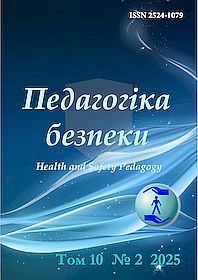Інтернет-залежність серед студентів: симптоми, наслідки та методи подолання
DOI:
https://doi.org/10.31649/2524-1079-2025-10-2-092-102Ключові слова:
інтернет-залежність, цифрова грамотність, психічне здоров’я, соціальна адаптація, кіберзахист.Анотація
У статті розглянуто проблему інтернет-залежності серед молоді, зокрема студентів, яка набуває все більшої актуальності у сучасному цифровому світі. Проаналізовано основні симптоми та негативні наслідки цього розладу, включаючи зниження академічної успішності, емоційне виснаження, соціальну ізоляцію, порушення сну та психічні розлади. Особлива увага приділяється факторам, що сприяють розвитку інтернет-залежності, таким як емоційна нестабільність, тривожність, низька самооцінка та бажання уникнути труднощів реального життя. Запропоновано ефективні методи профілактики та корекції залежності, що базуються на комплексному підході до психологічної підтримки, навчання цифровій гігієні та розвитку навичок саморегуляції.
Метою роботи є дослідження впливу інтернет-залежності на студентську молодь, виявлення основних чинників її розвитку, аналіз соціальних, психологічних та академічних наслідків, а також розробка ефективних підходів до профілактики та подолання цього розладу.
На основі проведеного аналіз запропоновано профілактику рекомендації щодо інтернет-залежності серед студентів, що вимагають комплексного підходу, який включає розвиток самоусвідомлення, цифрової грамотності та навичок саморегуляції. Важливу роль у цьому процесі відіграють освітні установи, що можуть забезпечити доступ до кваліфікованих психологічних консультацій та створити умови для здорового цифрового середовища.
Посилання
American Psychological Association. (2020). Health advisory on social media use in adolescence. Retrieved from https://www.apa.org/topics/social-media-internet/health-advisory-adolescent-social-media-use
Andreassen, C. S., et al. (2017). The relationship between addictive use of social media and video games and symptoms of psychiatric disorders: A large-scale cross-sectional study. Psychology of Addictive Behaviors, 31(3), 252–262. https://doi.org/10.1037/adb0000319.
Bartkiv, O. (2019). Sotsialno-pedahohichna profilaktyka Internet-adyktsii u studentskoi molodi [Socio-pedagogical prevention of Internet addiction in students]. Vyshcha shkola Skhidnoievropeiskoho natsionalnoho universytetu imeni Lesi Ukrainky. https://core.ac.uk/download/pdf/153580452.pdf. [in Ukrainian].
Buckingham, D. (2008). Youth, identity, and digital media. The MIT Press. [in English].
Caplan, S. E. (2002). Problematic Internet use and psychosocial well-being: Development of a theory-based cognitive–behavioral measurement instrument. Computers in Human Behavior, 18(5), 553–575. https://doi.org/10.1016/S0747-5632(02)00004-3.
Computer Economics. (2009). Internet Addiction Research Report. [Internal archive].
ESPAD Group. (2020). ESPAD Report 2019: Results from the European School Survey Project on Alcohol and Other Drugs. Publications Office of the European Union. https://doi.org/10.2810/970957
Goldberg, I. (1995). Internet Addiction Disorder. Retrieved from http://www.cog.brown.edu/brochure/people/duchon/humor/internet.addiction.html
Isaeva, E., & Sokolov, A. (2021). Communication strategy of a community of non-profit organizations and civic activists on social network sites: Problems and perspectives. Proceedings of the 2021 Communication Strategies in Digital Society Workshop (ComSDS), 43–46. https://doi.org/10.1109/ComSDS52473.2021.9422866.
Hrechanovska, O. V., Mehem, O. M., & Potapiuk, L. M. (2023). Vplyv sotsialnykh merezh na psykholohichnyi stan ta samootsinku ukrainskoi molodi. Scientific Notes of V. I. Vernadsky Taurida National University. Series: Psychology, 34(73)(4), 60–66. https://doi.org/10.32782/2709-3093/2023.4/11 [in Ukrainian]
Hryshko, V. V. (2021). Internet-zalezhnist studentiv [Internet addiction of students]. Visnyk psykholohii i pedahohiky. https://www.psyh.kiev.ua/%D0%86%D0%BD%D1%82%D0%B5%D1%80%D0%BD%D0%B5%D1%82-%D0%B7%D0%B0%D0%BB%D0%B5%D0%B6%D0%BD%D1%96%D1%81%D1%82%D1%8C_%D1%81%D1%82%D1%83%D0%B4%D0%B5%D0%BD%D1%82%D1%96%D0%B2. [in Ukrainian].
Kuss, D. J., & Griffiths, M. D. (2012). Internet Addiction: A Systematic Review of Epidemiological Research for the Last Decade. Current Pharmaceutical Design, 18(18), 4907–4918. [in English].
Kuss, D. J., & Griffiths, M. D. (2015). Internet Addiction in Psychotherapy. Palgrave Macmillan. https://doi.org/10.1057/9781137465078.
Kuss, D. J., van Rooij, A. J., Shorter, G. W., Griffiths, M. D., & van de Mheen, D. (2013). Internet addiction in adolescents: Prevalence and risk factors. Computers in Human Behavior, 29(5), 1987–1996. https://doi.org/10.1016/j.chb.2013.04.002.
Kuss, D. J., & Griffiths, M. D. (2017). Social networking sites and addiction: Ten lessons learned. International Journal of Environmental Research and Public Health, 14(3), 311. https://doi.org/10.3390/ijerph14030311.
Savenko S. M., Yurtseniuk O. S., & Rotar S.S. (2020). Internet-zalezhnist – tse tezh khvoroba [Internet addiction is also a disease]. https://www.bsmu.edu.ua/blog/5440-internet-zalezhnist-tse-tezh-hvoroba/. [in Ukrainian].
Weinstein, A., & Lejoyeux, M. (2010). Internet Addiction or Excessive Internet Use. The American Journal of Drug and Alcohol Abuse, 36(5), 277–283. https://doi.org/10.3109/00952990.2010.491880.
Yablonska, T., & Yuanjie, L. (2023). Psychological characteristics of young men with Internet addiction: A cross-cultural study. Scientific Bulletin of Mukachevo State University. Series “Pedagogy and Psychology”, 9(3), 91-101. https://doi.org/10.52534/msu-pp3.2023.91
Young, K. S. (1998). Internet addiction: The emergence of a new clinical disorder. CyberPsychology & Behavior, 1(3), 237–244. https://doi.org/10.1089/cpb.1998.1.237.
Young, K. S. (1999). Internet Addiction: Symptoms, Evaluation and Treatment. In Innovations in Clinical Practice: A Source Book, 17, 19–31.
Young, K. S. (2004). Internet Addiction: A New Clinical Phenomenon and Its Consequences. American Behavioral Scientist, 48(4), 402–415. https://doi.org/10.1177/0002764204270278.
Young, K. S. (2017). Internet addiction. In Internet Addiction: A Handbook and Guide to Evaluation and Treatment (pp. 3–16). John Wiley & Sons.
Yuan, K., Qin, W., Wang, G., Zeng, F., Zhao, L., Yang, X., ..., & Tian, J. (2011). Microstructure abnormalities in adolescents with Internet addiction disorder. PLoS One, 6(6), e20708. https://doi.org/10.1371/journal.pone.0020708.
Yurchenko, Ye. Yu. (2020). Internet-zalezhnist ta shliakhy yii podolannia u pidlitkovomu vitsi [Internet addiction and ways to overcome it in adolescence]. Kryvorizkyi derzhavnyi pedahohichnyi universytet. https://ekhsuir.kspu.edu/bitstream/handle/123456789/13726/%D0%AE%D1%80%D1%87%D0%B5%D0%BD%D0%BA%D0%BE%20%D0%84.%D0%AE..pdf?sequence=2&isAllowed=y. [in Ukrainian].
Yuryeva, L., & Shornikov, A. (2023). Cyber addiction: A new view and approaches to diagnostics. In Modern Methods of Diagnosing Diseases (pp. 132–161). Kharkiv: PC TECHNOLOGY CENTER. ISBN 978-617-7319-65-7. https://repo.dma.dp.ua/8390/ [in Ukrainian].
Zhou, Y., Lin, F. C., Du, Y. S., Qin, L. D., Zhao, Z. M., Xu, J. R., & Lei, H. (2011). Gray matter abnormalities in Internet addiction: A voxel-based morphometry study. European Journal of Radiology, 79(1), 92–95. https://doi.org/10.1016/j.ejrad.2009.10.025.
##submission.downloads##
-
PDF
Завантажень: 49
Опубліковано
Як цитувати
Номер
Розділ
Ліцензія

Ця робота ліцензується відповідно до Creative Commons Attribution 4.0 International License.


